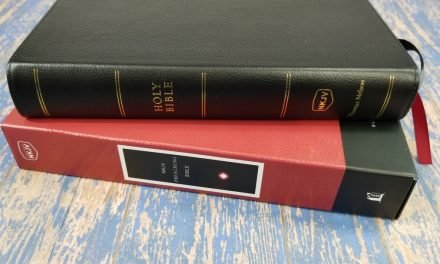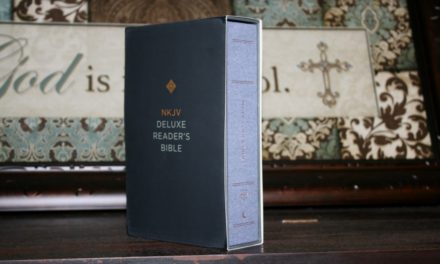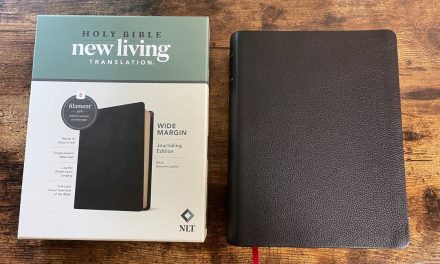
Before I get into my review of Amplified Bible, Large Print Edition, I want to take a few moments to talk about the Amplified Bible itself.
What is the Amplified Bible?
The Amplified Bible is the first translation produced by the Lockman Foundation. The Foundation tells us..
“The Amplified Bible is a translation that, by using synonyms and definitions, both explains and expands the meaning of words in the text by placing amplification in parentheses and brackets and after key words or phrases. This unique system of translation allows the reader to more completely grasp the meaning of the words as they were understood in the original languages. Through multiple expressions, fuller and more revealing appreciation is given to the divine message as the original text legitimately permits.”
The Amplified Bible is a formal equivalence (word for word) translation, and a very unique one at that. Sometimes, there can be more than one meaning to a word in Hebrew or Greek, sometimes the English translation is difficult to understand. The amplifications give alternate meanings, define the more difficult concepts and generally make the text easier to understand while remaining a word for word translation.
Let’s explain Formal Equivalence a little better before we continue. Often it is called a “word-for-word” or “literal” translation, the principle of formal equivalence “seeks as nearly as possible to preserve the structure of the original language. It seeks to represent each word of the translated text with an exact equivalent word in the translation so that the reader can see word for word what the original human author wrote” (The Apologetics Study Bible, p. xviii). Advantages of formal equivalence include: (a) consistency with the conviction that the Holy Spirit inspired not just the thoughts but the very words of Scripture; (b) access to the structure of the text in the original language; and (c) accuracy to the degree that English has an exact equivalent for each word. Drawbacks include sometimes awkward English or a misunderstanding of the author’s intent. The only truly formal equivalence translation is an interlinear version that tries to render each Hebrew, Aramaic, or Greek word with an English equivalent without changing the word order. Translations that tend to follow a formal equivalence philosophy are the King James Version (KJV), New King James Version (NKJV), the New American Standard Bible (NASB), the English Standard Version (ESV), and The Amplified Bible. Of these, NASB is the strictest for Formal Equivalence and Amplified is the most practical.
Amplified Bible is not without its criticisms though. (The Amplified Bible can be a valuable study tool, as the different “alternate” renderings can give additional insight into the meaning of a text.) The problem is the words the Amplified gives alternate renderings for can mean those things, but do not necessarily mean all of those things. The fact that a word can have different meanings does not mean that every possible meaning is a valid rendering each time the word occurs. Also, it being based on the American Standard Version results in some of its wordings sounding archaic.
All in all, the Amplified is a good choice for both study and teaching, especially if you are teaching younger people or those new to the Bible. In the interest of honesty, I will say that I do not find that the Amplified lends itself to reading aloud.
Amplified Bible, Large Print
Product Information
Format: Bonded Leather
Number of Pages: 1984
Vendor: Zondervan
Publication Date: 1995
Dimensions: 9.75 X 6.75 X 1.5 (inches)
ISBN: 0310951836
ISBN-13: 9780310951834
Text Layout: Double Column
Text Size: 12 Point
Text Color: Black Letter
My Review:
The first thing you will notice is how soft the leather feels. This is a bonded leather product, and, while bonded is not the highest grade leather, this leather is very supple and soft. The smythe sewn binding allows for the Bible to lay flat wherever you open it and easily used one handed.
The text, oh man, the text is spectacular. It is a gorgeous and gigantic 12 point font, among the most generous fonts available. I would easily stack it up against my Holman Giant Print KJV. I could not find information on the opacity of the paper, but I will tell you that ghosting is negligible at best. You should be able to highlight or underline with no issues.
Unfortunately this edition has no concordance; there is a glossary, which seems redundant given the textual amplifications. On the other hand, there are a number of translator’s notes available on many of the pages. In fact, the notes are so prodigious that they rival even the NASB and HCSB Bibles.
Each book comes with a brief introduction and outline to help give you an overview of the book you are studying.
The margins are small. There is no way around it; if you can write in small print that should not be an issue. To their credit, Lockman and Zondervan have released an Amplified Bible Note Taker’s Edition (to be reviewed later) which gives you the generous margins that I love but compromises on text size. Notes pages would be nice, but this particular Bible seems more designed for practical use and not as a primary study tool.
There really is nothing about this Bible to be dissatisfied with. Any perceived negatives are my own niggling little quirks and most likely will not bother the average user.
Overall, I rate it a 9. I think the lack of helps is what keeps me from giving a perfect 10.
If you haven’t purchased an Amplified Bible before, purchase this edition, here or the Note Takers Edition, here, or the Standard Version, here.




This Bible was provided free of charge by the Lockman Foundation. No comments or positive remarks were solicited and these are my own thoughts.











Dear Matthew:
This is a product I’ve not seen before. I was able to read the text of Isaiah 45 from the screen and could see for myself the differences when I compared it to my 1st Edition NASB that Foundation published for Lockman, There is lots more information with the alternate possibilities of the translation right on the page rather than in reference columns like the Westminister Reference Bible does. As you know, I had and used as a primary bible the 1st NASB edition, and because of the way it was translated often seemed stiff sounding. I did find that when I checked, it was accurate almost to a flaw. Setting aside other issues, I found the NASB perhaps the best of the modern translations.
This amplifed bible perhaps is best reserved for study, cross checking references etc. What I could see on the screen gave lots of content, but made reading a chore. There seems to be a wealth of detail to help the reader to understand the content without having to resort to original language. I wonder if anyone has produced a similar product based on the Authorised bible? Nevertheless, this effort seems to be an excellent tool for study, but not for general reading or carrying. One of the reasons I returned to the Authorised was that the NASB seemed to me stiff and not flowing and graceful like the Authorised, falling short in elegance to that old familiar language. If one is looking for more information about translation options without learning Greek, Hebrew, and Aramaic, this may be the answer to this quest.
Congratulations on a good review, you have been successful in describing this bible, I hope that its readers find it useful.
Yours In Christ
Don Denison